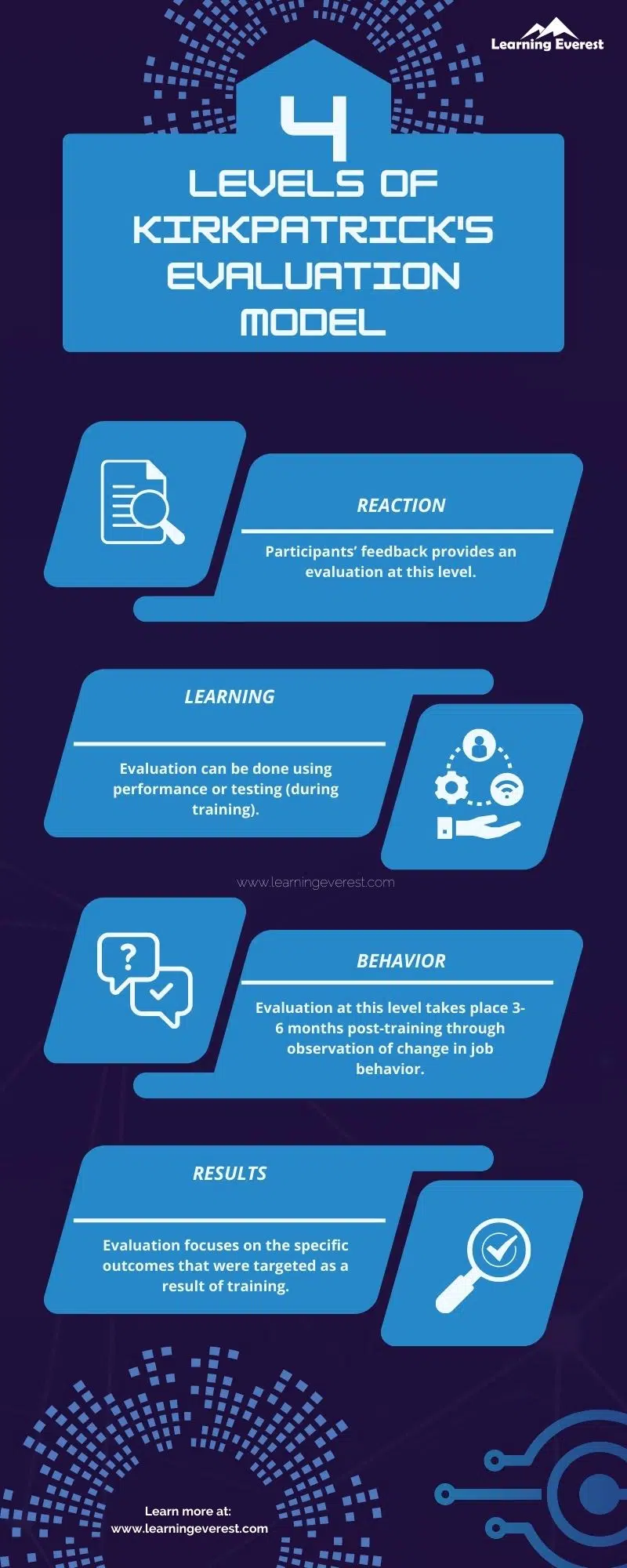Kirkpatrick evaluation model for training effectiveness is not one-dimensional. Just as we need to utilize multidimensional measures to assess the effectiveness of employee performance, training effectiveness requires attention to several critical aspects of training as well. Are learners putting their learning into practice? Can they transform their knowledge into skill? Is it positively impacting their role in the organization? A 2015 report on workplace training by 24x7 Learning Inc. found that just 11% of the employees can fully use the training in their job. This statistic shows a significant disconnect between what the training organizations offer and what their employees actually need.
Table of Contents
- What is the Kirkpatrick evaluation model?
- Kirkpatrick’s four levels of training evaluation
- How to enable an effective Kirkpatrick evaluation model?
- Advantages of the Kirkpatrick evaluation model
- Disadvantages of the Kirkpatrick evaluation model
- Infographics
- Conclusion
- Knowledge Check!
- Frequently Asked Questions (FAQs)
- What is the Kirkpatrick’s evaluation model?
- Who invented Kirkpatrick Model?
- Is the Kirkpatrick Model the best way to measure learning effectiveness?
- What are the 4 levels of evaluation and how are they significant?
Kirkpatrick’s four-level training evaluation model can help to answer questions. One can use it to objectively analyze the impact of training, work out how well the team members learned, and improve their learning in the future. In this blog, we will talk about the effectiveness of the Kirkpatrick evaluation model in workplace training.
What is the Kirkpatrick evaluation model?
Donald Kirkpatrick’s doctoral dissertation “Evaluating Human Relations Programs for Industrial Foremen and Supervisors”, outlined the criteria for assessing training effectiveness in business and industry. Donald Kirkpatrick first published his model in 1959. He then updated it in 1975 and again in 1993. It is known as the Kirkpatrick evaluation model.
The Kirkpatrick evaluation model is a structural tool for evaluating and analyzing the effectiveness of training and learning programs. It has four levels of evaluation: reaction, learning, behavior, and results. Each successive level of the model represents a more precise measure of the effectiveness of a training program.
A 2009 survey from the Institute for Corporate Productivity of businesses, human resources, and learning professionals found that the Kirkpatrick evaluation model is the most commonly used tool for assessing training effectiveness. In 2010, the new world Kirkpatrick evaluation model, the most recent edition, gives the users a more robust model to work with. Users of the model can either start at level one and work up the model in its complexity or begin at level four and work backward.
Kirkpatrick’s four levels of training evaluation
Level 1: Reaction
Reaction implies how favorably the learners have responded to the training. Learners’ feedback provides an evaluation at this level. This evaluation is primarily quantitative. It examines the degree to which participants enjoyed and engaged with the materials of training. During this level, evaluators can glean how the intended learners received the program. By evaluating this level of the model, one can determine whether content delivery needs to be adjusted.
One can send a survey immediately following the session to learn what the employees think about the training program. Consider asking questions like the following:
- Was the module engaging?
- Did you feel the training was worthy of your time?
- Can you use the skills you learned in your job?
- Did you enjoy the training’s approach or style?
- What aspects of upcoming training would you wish to alter or enhance?
- What tools will you need to put what you’ve learned into practice?
One can also track participation and completion rates using the Kirkpatrick evaluation model. Using the feedback, one can identify areas for improvement and consider possible changes for future iterations of the training program.
Level 2: Learning
At the learning level, the focus moves to the new learning that results from the training. The evaluation is done based on the change in the ASK (Attitudes, skills, and knowledge) of the trainees. The evaluation involves observing and analyzing the voice, behavior, and text. Other tools besides observation are interviews, surveys, pre-and post-tests, etc.
It builds off the satisfaction scores to explore whether participants acquired the knowledge, skills, attitudes, confidence, and commitment to the training content. This level increases the complexity of the Kirkpatrick evaluation model to compare the training content with what the learners learned from it.
Level 3: Behavior
At the behavior level, the focus is on the transfer of learning. Evaluation at this level takes place 3-6 months post-training through observation of change in job behavior. Behavior evaluation analyses the transfer of knowledge from the training modules to the workplace. This level evaluates whether participants plan to change their behaviors based on the training. Especially planning for how transferable the training is when the participants return to their jobs, the focus is on actionable change. Here the primary tool for evaluation is mostly observation.
To measure behavior, one can conduct interviews, record observations, and provide opportunities in the form of projects for team members to use the skills they just learned. Apart from the observation, facilitators can also use questionnaires and 360 feedback.
Also remember, just because there hasn’t been a change in behavior doesn’t indicate the training wasn’t successful. To make sure that one is creating an environment that promotes learning and constructive change, one also needs to evaluate the current procedures and the cultural condition of the organization.
Level 4: Results
At the results level, the focus is on the targeted outcomes. At this stage, the users evaluate how the behavioral changes impacted the business and whether the training investment resulted in a good return on investment (ROI). The results depend on the training program’s goal. Evaluators appraise the targeted outcomes as a result of the training. This level determines whether the program achieved its intended goals during training.
How to enable an effective Kirkpatrick evaluation model?
There are many considerations for administering the Kirkpatrick evaluation model, including how to write appropriate questions, when to collect data, and how to choose the most effective data collection method for the questions asked. Depending on the training design, one may need to collect information before and after the training to be more confident that the trainees learned all the material. Paper-and-pencil and online surveys are generally the most common ways to collect training evaluation data.
In addition to surveys, many items can be observed, including the trainee’s on-the-job behaviors assessed by trainers, peers, subordinates, or superiors. While drafting survey questions may seem easy, writing questions that are easily measurable and can provide confidence in the results has some essential guidelines. Subjective questions are best for assessing a person’s perceptions about the training session or something the individual learned during the training. Objective questions are best for gathering metrics for evaluating outcomes or results. Seek to obtain answers that provide rich information to improve the training delivery and effectiveness.
Advantages of the Kirkpatrick evaluation model
The Kirkpatrick evaluation model has several advantages that make it an attractive choice for trainers and other business leaders:
- It provides a clear evaluative structure to follow.
- It works with traditional and digital learning and development programs.
- It gives business leaders valuable insight into the training programs and the impact of it on their business.
- Moreover, its simple approach is flexible and adaptable across industries, making it easier for trainers to implement the model.
Disadvantages of the Kirkpatrick evaluation model
There are also a few disadvantages of using the Kirkpatrick evaluation model:
- It can be a bit time-consuming and requires costly investment to conduct all the pre-tests, post-tests, and analyses of learning outcomes.
- It is also challenging to link business results to specific training directly. Demonstrating effectiveness and return on investment (ROI) is challenging since the causes are sometimes complex and multifaceted. And to do so accurately it requires additional resources and expertise.
Infographics
Conclusion
Training is a valuable investment and is one of the most important factors in learning and development. It can improve employee satisfaction, positive outcomes, and economic efficiency. The Kirkpatrick evaluation model is an appropriate model for evaluating training programs. The characteristics of the Kirkpatrick evaluation model include the simplicity of the process, measurement of a limited number of variables, ease of evaluation criteria, lack of need to collect the primary data and learners’ previous performance, and independence of individual and environmental variables. Although all models have some deficiencies, this model has a suitable and acceptable performance for assessing training programs.
Click here to read about Donald Kirkpatrick
Knowledge Check!
Frequently Asked Questions (FAQs)
What is the Kirkpatrick’s evaluation model?
The Kirkpatrick evaluation model is a structural tool for evaluating and analyzing the effectiveness of training and learning programs. It has four levels of evaluation: reaction, learning, behavior, and results.
Who invented Kirkpatrick Model?
Donald Kirkpatrick invented the Kirkpatrick evaluation model.
Is the Kirkpatrick Model the best way to measure learning effectiveness?
The Kirkpatrick evaluation model is an appropriate model for evaluating training programs. The characteristics of the Kirkpatrick evaluation model include the simplicity of the process, measurement of a limited number of variables, ease of evaluation criteria, lack of need to collect the primary data and learners’ previous performance, and independence of individual and environmental variables.
What are the 4 levels of evaluation and how are they significant?
The four levels of the Kirkpatrick evaluation model are reaction, learning, behavior, and results. Its simple approach is flexible and adaptable across industries, making it easier for trainers to implement the model.






